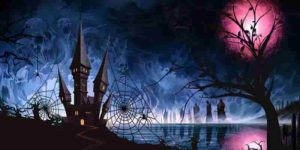To build the ultimate tiefling hexblade warlock in DnD 5e, consider
- Tiefling’s inherent abilities
- Build for combat
- Choose warlock spells for combat build
- Utilize Eldritch invocations to boost magic
- Try Pact of the Chain for a flying familiar
- Understand Hexblade abilities and magic
Tiefling hexblade warlocks are dark spell swords with inherently boosted magic. They’re infernal, menacing and naturally gifted with warlock magic. Especially in this form—a black knight with a cursed weapon—tieflings can utilize their innate bonuses and magic.
Unlike most spellcasters, this build leans into martial combat a great deal. This might be perfect for a warlock build, however, as they have the fewest spell slots available. I’ll be able to gain benefits to melee combat while saving spells for special occasions.
Before we jump in, check out my original pirate adventure, Dead Man’s Tale, and give your new Hexblade Warlock a run in a premade adventure. Click here or below to learn more.
Tiefling’s inherent abilities
As you might have guessed, tieflings fit this role quite well. Thematically speaking, their devilish appearance and infernal knowledge set them up for darker character roles.
Tieflings receive a +2 Charisma bonus, the most important score for a warlock, and a +1 bonus to Intelligence. Because hexblade warlocks can use their Charisma score for damage, I won’t need to worry so much about Strength or Dexterity. I only need enough Strength to wear a breastplate or chainmail.
In addition to this ability bonus, tieflings come with Darkvision, Hellish Resistance and Infernal Legacy.
The first two are straight forward abilities. Darkvision allows me to see in the dark up to 60 feet, and Hellish Resistance gives me resistance to fire damage.
Infernal Legacy, however, grants me a few inherent spells. The first spell is thaumaturgy, which is one of the strangest cantrips to me. It essentially means the ability to perform spooky paranormal stuff. Seriously, there’s a list that ranges from disembodied voices to doors slamming to candles flickering. This could be fantastic for intimidation.
Hellish rebuke comes in at level 3, which is absolutely gnarly. Whenever I’m damaged by an enemy, I can use my reaction to deal 3d10 fire damage on a failed Dexterity saving throw. If that sounds outrageous, that’s because the spell normally does 2d10 as a 1st level spell. Tieflings are allowed to cast this as a 2nd level spell, upgrading the damage an extra 1d10. I’ll only get one per rest, but what a nuke for level 3.
On the opposite side of the infernal spectrum, level 5 gives us darkness. This spell, as you can imagine, creates a spread of pitch black across a 15-foot area. Creatures with darkvision can’t see through it, nor can nonmagical light penetrate it.
Build for combat
Unlike most spell casters, the hexblade warlock is uniquely built for close quarters combat.
Because I can use my Charisma as my damage modifier, I can crank this score up as high as possible. My spells and melee damage will use the same Charisma score. My next highest score should probably be Constitution, to increase my ability to take damage. I will be in the fray, so I need to be conscious of defense as well.
Related Posts:
Guide to Building a Shadow Sorcerer DnD 5e
| Guide to Building a Warlock Undead Patron: DnD 5e
|
In fact, I will wear heavier armor, probably chainmail or partial plate and wield a longsword. I’ll keep my other hand free for spellcasting. This way, I can choose to upgrade my base sword damage by wielding it with both hands or blast enemies with my free hand.
I love the idea of surprising an enemy with hellish rebuke during a sword fight.
Choose warlock spells for combat build
Now that I’ve decided to take my character in a “black knight” direction, I’ll think of spells in that regard. This type of build won’t be the usual spell caster. They’ll be intelligent, perhaps, but not the scholarly mage. I’m a devilish warlock with a cursed sword—my spells should reflect that.
Warlocks receive fewer options or opportunities as other spell casters but have unique abilities that come into play. They utilize a system called pact magic to channel their otherworldly patron—this particular patron being trapped in a longsword. I’ll begin with 2 cantrips and 2 first-level spells, with one spell slot, to begin.
Cantrips
My main cantrip will be eldritch blast.
Eldritch blast is described as a beam of cackling energy. So, it’s like the emperor in Star Wars… but shooting out a beam that deals 1d12. As far as I’m concerned, I don’t need many damage options as a cantrip. Plus, warlocks can gain unique effects on this particular spell, and I can hit ranged targets.
Slot spells
As far as 1st level spells go, I’ll have to go with armor of Agathys and arms of Hadar. Sounds spooky.
Armor of Agathys spreads a spectral frost over me, giving me a ghostly sheet of armor. I’ll add 5 temporary hit points to my life total. Then, when I’m hit buy an enemy, they’ll receive 5 cold damage in retaliation. I don’t know what it is about punishing those who hit me, but it seems like a cool trope to roll with.
Arms of Hadar is an insane burst of black, ethereal tendrils that slam into everything within 10 feet of me. I like to think of this spell as tentacle-like. Each enemy takes 2d6 necrotic damage on a failed Strength saving throw and can’t take reactions until its next turn. As usual, enemies still take half damage on successful saves with nothing additional.
Utilize Eldritch invocations to boost magic
I’m a real sucker for cranking a class effect up to 11. And because I chose eldritch blast as a cantrip, I think I’ll triple down on that spell
Eldritch Invocations are unique spell effects offered to warlocks through their pact magic. If other spell casters have an advantage of options, warlocks have advantage on individual spells. With agonizing blast and repelling blast, I can add some fun to my go-to eldritch blast.
Agonizing blast adds my Charisma modifier to the damage roll of eldritch blast, and repelling blast sends enemies flying 10 feet away. The extra damage is obviously nice, but the repelling effect should help me from being swarmed. It’s going to be fun blasting away in a room.
Try Pact of the Chain for a flying familiar
Honestly, it was had to choose a Pact Boon between Pact of the Chain, Blade or Tome. Each offers helpful and cool magic effects, but I had to go with Pact of the Chain.
This Pact Boon allows me to find familiar—either a pseudodragon, imp, sprite or quasit. For me, the choice was clear. I needed a little imp buddy to fly around my head.
There are so many uses for this flying companion. It’s essentially a pet, but a darkly magic one. Oh, and it can fly, and I can talk to it. It’s too cool. With this dynamic, I feel like I can add some fun to the story instead of merely existing to kill. Because trust me, this character has all kinds of kill options already.
Also, little buddy can attack in place of me.
Understand Hexblade abilities and magic
As we knew off the rip, my patron is a cursed sword. I chose the hexblade path, which offers its own brand of patron magic.
First, the hexblade offers me several new spells: shield, wrathful smite, blur, branding smite, blink, elemental weapon and more. Needless to say, I have an array of battle-friendly spells to aid in my slaughter.
Hexblade’s Curse is an ability that allows me to set a curse on an enemy and gain special bonuses against them. The first feature is that I gain bonus damage against that enemy equal to my proficiency. Any attack rolls of 19 and 20 both count as critical rolls. Finally, after the target dies, I regain hp equal to my warlock level + Charisma modifier.
Hex Warrior is the ability that lets me use my Charisma modifier for melee attacks. Another bonus is the proficiency is medium armor, shields and martial weapons.
Accursed Specter is another fun ability that rolls in at level 6. Whenever I slay a foe, I can raise their ghost to act as my thrall. The spirit gains hit points equal to half my warlock level. The fact that I can now raise ghosts to fight for me, while my devilish imp flies around, is just so gothic.
So, what do you think?
Well, I’ve written many character builds, but this is the first that might be overpowered. Between the hellish rebuke, sword buffs, high-caliber eldritch blasts and other bag of dark goodies, this character is crazy.
Related Posts:
Guide to Building a Haunted House Adventure DnD 5e
| Guide to Building a Bard College of Creation: DnD 5e
|
Disclaimer:
Genre Bomb is unofficial Fan Content permitted under the Fan Content Policy. Not approved/endorsed by Wizards. Portions of the materials used are property of Wizards of the Coast. ©Wizards of the Coast LLC.







Thanks for this great information sharing, i really like the combination of eldritch blast and agonizing blast you mentioned, by using invocations. Very well written articles easily understandable. Following your blog for more warlock stuff. Thanks alot.
Thank you! I’ll have to cook up some more warlock-specific ideas in the near future for ya
Hello. Thank you for sharing this. What about Patron?
Hey Joshua, thanks for the comment! Hexblades have a more mysterious origin from the Shadowfell, so they don’t necessarily have a single Patron. The Shadowfell itself is spooky like that–the mystery makes it creepier. That being said, the Raven Queen could be a cool Shadowfell Patron to use for fun.